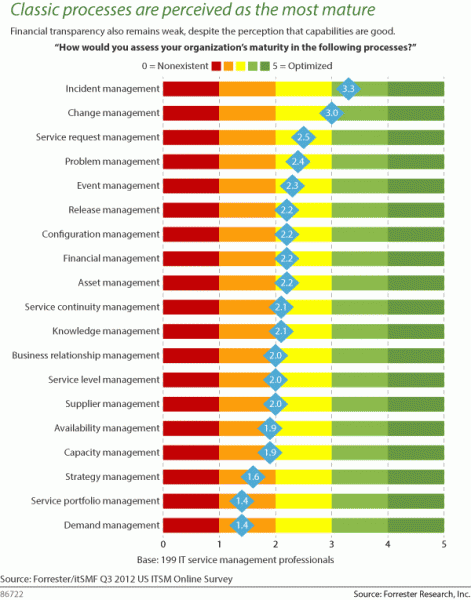Does ITSM Still Have Relevance In The Empowered BT Era?
In August this year I am heading down to our nation’s capital to take part in the annual itSMF Australia event – LEADit. I have taken part in this event to a greater or lesser extent over the past few years across Australia – Sydney, Perth, the Gold Coast and now Canberra. As an analyst who broadly covers the Service Management space (as well as a previously ITIL qualified practitioner), this event is the mecca for those interested in service management in Australia.
Year after year at this event, I see a fair amount of change in the content and focus, but little change in the thinking, and little real movement in the implementation or improvement of the processes – a recent survey between itSMF-USA and Forrester displays the current maturity levels of processes in organisations:
Here we are – years (decades?) after the first ITIL books were written, and demand management is STILL immature. Even financial management has barely shifted in maturity over the past few years. Why is this the case?
In my opinion, the issue is with the S in ITSM. For the most part, organisations have not yet defined what the actual technology-based services are that they deliver. If I put my suit in to be dry cleaned, I care that it is cleaned and available when I was told it would be available. I don’t want to pay over the odds; I don’t want it to be dirty when I pick it up; and most importantly, I don’t want someone else’s suit. I don’t care who they ordered the dry cleaning fluid from – I don’t even care what sort of dry cleaning fluid they use. I don’t care about the machine, the booking system or anything else in the process. ITSM tends to have its head stuck in the details, ignoring the actual service that the customer receives or wants.
That said, I believe things are changing – in our clients based in Asia I have seen an increasing interest in a new role – a “Service Manager” – someone who has oversight across all the business services that IT plays a role in delivering. Such a role can start to measure the impact of technology on business outcomes – and will help the IT team prioritise the services and processes they need to manage most effectively.
The shift to Empowered Business Technology has made it easier to relate technology investments and processes to business value. Your organisation’s employees are bringing in external technology-centric services in order to drive a direct outcome. The link between business/customer value and the technology is obvious.
Therefore, the future for ITSM is bright. For too long ITSM was about IT Process Management; however this is beginning to change. I am hoping that the learnings that come out of LEADit will help the ITSM community in Australia drive a focus on service provision and service portfolio management. That’ll be the focus of my involvement anyway!
See you there!
To learn more about how you can improve your ITSM capabilities, check out Forrester’s Service Management And Automation Playbook. For me, the title of the “vision report” says it all: Become Customer-Centric, Service-Focused, And Automated.
